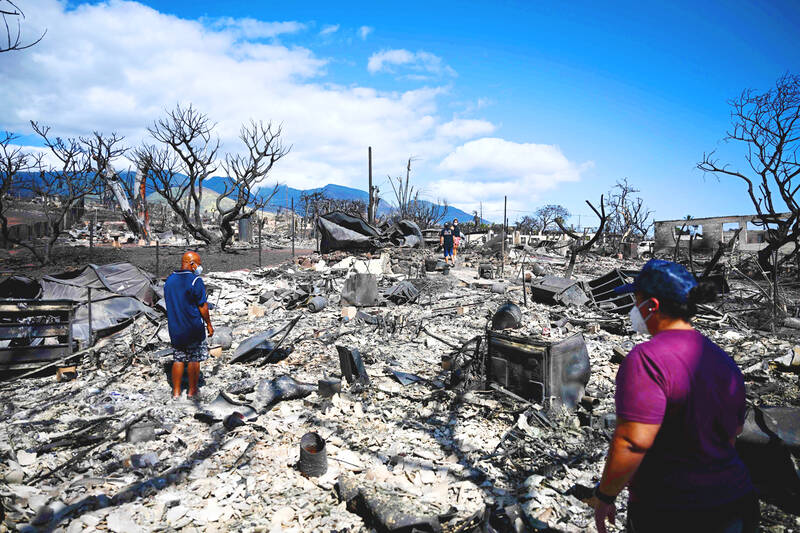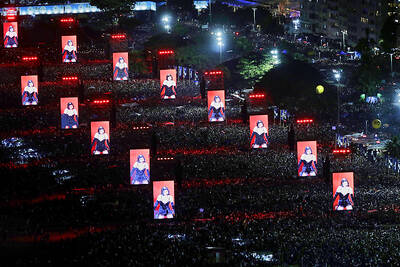The death toll has risen to 80 as a result of the wildfires that devastated parts of the island of Maui this past week, officials in Hawaii said on Friday.
The number of confirmed fatalities in the 9pm announcement by Maui County increased from the previous figure of 67.
Hawaii Governor Josh Green had previously said that the death toll would likely rise as search-and-rescue operations continue. Authorities set a curfew from 10pm until 6am yesterday.

Photo: AFP
“The recovery’s going to be extraordinarily complicated, but we do want people to get back to their homes and just do what they can to assess safely, because it’s pretty dangerous,” Green told Hawaii News Now.
Cadaver-sniffing dogs were deployed to search for the dead, Maui County Mayor Richard Bissen Jr said.
Blackened hulks of burned-out vehicles were visible outside homes, as the pavement was streaked with melted and then rehardened chrome. Along with block after block of flattened homes and businesses, incinerated telephone poles lined the streets, while elevator shafts rose from ashy lots where apartment buildings once stood. A truck bed full of glass bottles was warped into surreal shapes by the furious heat.
Anthony Garcia assessed the devastation as he stood under Lahaina’s iconic banyan tree, now charred, and swept twisted branches into neat piles next to another heap filled with dead animals: cats, roosters and other birds killed by the smoke and flames. Somehow it made sense in a world turned upside-down.
“If I don’t do something, I’ll go nuts,” said Garcia, who lost everything he owned. “I’m losing my faith in God.”
Garcia and other residents were faced with widespread destruction as they took stock of their shattered homes and lives on Friday resulting from the wildfires that tore through parts of Maui this week and were still short of full containment.
A new fire on Friday evening triggered the evacuation of Kaanapali in West Maui, a community northeast of the area that burned earlier, the Maui Police Department announced on social media.
The fire, which was extinguished before 8:30pm, occurred in an area where a county fueling station was set up to distribute about 11,356 liters of gasoline and 1,892 liters of diesel fuel for about 400 waiting vehicles.
Hawaii Attorney General Anne Lopez announced plans to conduct a comprehensive review of decisionmaking and standing policies affecting the response to the deadly wildfires.
“My Department is committed to understanding the decisions that were made before and during the wildfires and to sharing with the public the results of this review,” Lopez said in a statement.
The wildfires are the state’s deadliest natural disaster in decades, surpassing a 1960 tsunami that killed 61 people. An even deadlier tsunami in 1946, which killed more than 150 on the Big Island, prompted development of a territory-wide emergency system with sirens that are tested monthly.
Many fire survivors said they didn’t hear any sirens or receive a warning giving them enough time to prepare, realizing they were in danger only when they saw flames or heard explosions.
“There was no warning,” said Lynn Robinson, who lost her home.
Hawaii emergency management records do no indicate warning sirens sounded before people had to run for their lives. Officials sent alerts to mobile phones, televisions and radio stations, but widespread power and cellular outages might have limited their reach.

Kehinde Sanni spends his days smoothing out dents and repainting scratched bumpers in a modest autobody shop in Lagos. He has never left Nigeria, yet he speaks glowingly of Burkina Faso military leader Ibrahim Traore. “Nigeria needs someone like Ibrahim Traore of Burkina Faso. He is doing well for his country,” Sanni said. His admiration is shaped by a steady stream of viral videos, memes and social media posts — many misleading or outright false — portraying Traore as a fearless reformer who defied Western powers and reclaimed his country’s dignity. The Burkinabe strongman swept into power following a coup in September 2022

‘FRAGMENTING’: British politics have for a long time been dominated by the Labor Party and the Tories, but polls suggest that Reform now poses a significant challenge Hard-right upstarts Reform UK snatched a parliamentary seat from British Prime Minister Keir Starmer’s Labor Party yesterday in local elections that dealt a blow to the UK’s two establishment parties. Reform, led by anti-immigrant firebrand Nigel Farage, won the by-election in Runcorn and Helsby in northwest England by just six votes, as it picked up gains in other localities, including one mayoralty. The group’s strong showing continues momentum it built up at last year’s general election and appears to confirm a trend that the UK is entering an era of multi-party politics. “For the movement, for the party it’s a very, very big

A new online voting system aimed at boosting turnout among the Philippines’ millions of overseas workers ahead of Monday’s mid-term elections has been marked by confusion and fears of disenfranchisement. Thousands of overseas Filipino workers have already cast their ballots in the race dominated by a bitter feud between President Ferdinand Marcos Jr and his impeached vice president, Sara Duterte. While official turnout figures are not yet publicly available, data from the Philippine Commission on Elections (COMELEC) showed that at least 134,000 of the 1.22 million registered overseas voters have signed up for the new online system, which opened on April 13. However,

ENTERTAINMENT: Rio officials have a history of organizing massive concerts on Copacabana Beach, with Madonna’s show drawing about 1.6 million fans last year Lady Gaga on Saturday night gave a free concert in front of 2 million fans who poured onto Copacabana Beach in Rio de Janeiro for the biggest show of her career. “Tonight, we’re making history... Thank you for making history with me,” Lady Gaga told a screaming crowd. The Mother Monster, as she is known, started the show at about 10:10pm local time with her 2011 song Bloody Mary. Cries of joy rose from the tightly packed fans who sang and danced shoulder-to-shoulder on the vast stretch of sand. Concert organizers said 2.1 million people attended the show. Lady Gaga